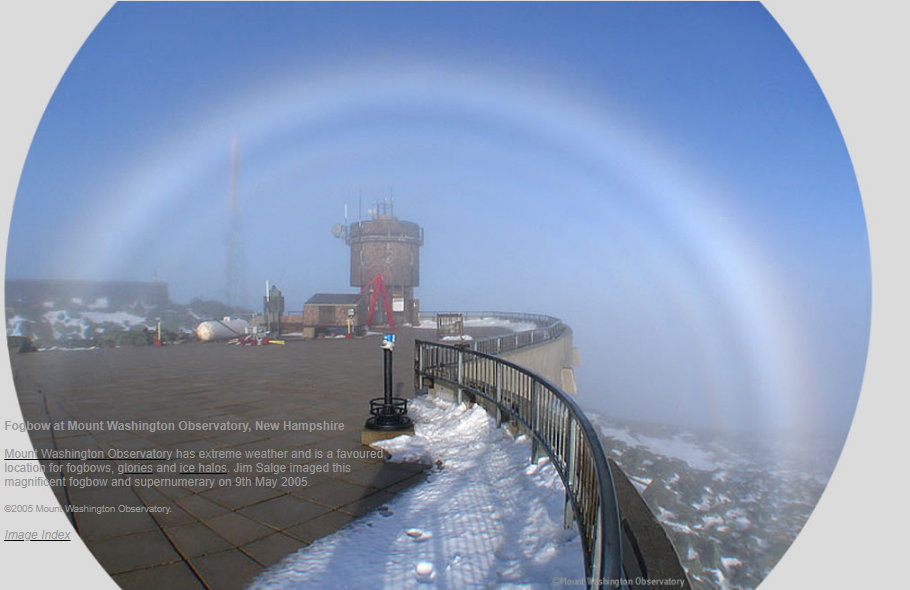Fogbow - Mount Washington Observatory
Fogbow - Mount Washington Observatory: A Spectacular Atmospheric Phenomenon
At the Mount Washington Observatory in New Hampshire, a place renowned for its extreme weather conditions, one can witness a captivating atmospheric phenomenon known as a fogbow. This stunning display of nature's artistry occurs when light interacts with tiny water droplets suspended in the air, creating a ghostly, ethereal bow-shaped formation. While fogbows may resemble rainbows, they possess distinct characteristics that set them apart and make them a fascinating subject of study.
Understanding the Science Behind Fogbows
Fogbows are a type of optical phenomenon known as a "supernumerary bow." They are formed when sunlight interacts with water droplets in foggy or misty conditions. Unlike rainbows, which result from the refraction and reflection of sunlight through raindrops, fogbows arise from the diffraction of light as it passes through small water droplets. The droplets are typically less than 0.05 millimeters in diameter, making them much smaller than raindrops.
The Appearance and Characteristics of Fogbows
Fogbows are characterized by their pale, almost white appearance, which is caused by the diffraction of light within the tiny droplets. Unlike rainbows, fogbows lack vibrant colors and instead exhibit a subtle range of pastel hues. This lack of color is due to the smaller size of the droplets and the absence of significant refraction and dispersion.
One unique feature of fogbows is the presence of supernumerary bows, which are additional, fainter bows that appear on the inside edge of the primary bow. These supernumerary bows result from interference patterns created by the diffraction of light within the droplets. Their presence adds an extra touch of beauty and complexity to the fogbow phenomenon.
Optimal Conditions for Observing Fogbows
The Mount Washington Observatory provides an ideal setting for observing fogbows due to its frequent foggy and misty weather conditions. Fogbows are most commonly seen in areas with dense fog or mist, where the air is saturated with moisture. Additionally, the angle of the sun is crucial for the formation and visibility of fogbows. The sun should be relatively low in the sky, typically less than 30 degrees above the horizon, for the fogbow to be visible.
The Role of Mount Washington Observatory
Mount Washington Observatory's location and climatic conditions make it a prime spot for studying and capturing images of fogbows. The observatory sits atop Mount Washington, the highest peak in the northeastern United States, and experiences some of the most extreme weather conditions in the world. The combination of high elevation, strong winds, and frequent fog provides an ideal environment for the formation of fogbows and other atmospheric phenomena.
Capturing the Beauty of Fogbows
Photographers and nature enthusiasts flock to Mount Washington Observatory to capture the mesmerizing beauty of fogbows. The ethereal nature of these phenomena, combined with the dramatic backdrop of the mountain landscape, creates breathtaking scenes that are a delight to behold. With the right timing and a keen eye, photographers can immortalize these fleeting moments of atmospheric magic.
Other Atmospheric Optics at Mount Washington Observatory
In addition to fogbows, Mount Washington Observatory is also renowned for its displays of glories and ice halos. Glories are colorful rings that encircle the shadow of an observer's head on a cloud or fog bank below. They are formed by the diffraction and interference of light within tiny water droplets or ice crystals. Ice halos, on the other hand, manifest as luminous rings or arcs around the sun or moon and are caused by the refraction, reflection, and dispersion of light through ice crystals in the atmosphere.
Conclusion
Fogbows at Mount Washington Observatory are a testament to the awe-inspiring wonders that can be found in nature. These ethereal formations, born from the interplay of light and water droplets, captivate the imagination and remind us of the beauty and complexity of our world. Whether witnessed firsthand or captured in photographs, fogbows are a breathtaking sight that continues to fascinate and inspire all who encounter them.

Fogbow at Mount Washington Observatory, New Hampshire
Mount Washington Observatory has extreme weather and is a favoured location for fogbows, glories and ice halos. Jim Salge imaged this magnificent fogbow and supernumerary on 9th May 2005.
©2005 Mount Washington Observatory.
Note: this article has been automatically converted from the old site and may not appear as intended. You can find the original article here.
Reference Atmospheric Optics
If you use any of the definitions, information, or data presented on Atmospheric Optics, please copy the link or reference below to properly credit us as the reference source. Thank you!
-
<a href="https://atoptics.co.uk/blog/fogbow-mount-washington-observatory/">Fogbow - Mount Washington Observatory</a>
-
"Fogbow - Mount Washington Observatory". Atmospheric Optics. Accessed on April 18, 2024. https://atoptics.co.uk/blog/fogbow-mount-washington-observatory/.
-
"Fogbow - Mount Washington Observatory". Atmospheric Optics, https://atoptics.co.uk/blog/fogbow-mount-washington-observatory/. Accessed 18 April, 2024
-
Fogbow - Mount Washington Observatory. Atmospheric Optics. Retrieved from https://atoptics.co.uk/blog/fogbow-mount-washington-observatory/.